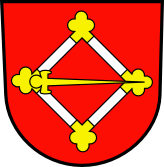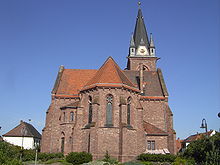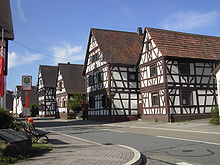Staffort: Difference between revisions
Link erg. |
Details |
||
| Line 11: | Line 11: | ||
[[File:Klotz Verlagshaus - Das Stafforter Buch.jpg|thumb|Das Stafforter Buch in aktueller Sprache - J. S. Klotz Verlagshaus]] |
[[File:Klotz Verlagshaus - Das Stafforter Buch.jpg|thumb|Das Stafforter Buch in aktueller Sprache - J. S. Klotz Verlagshaus]] |
||
The [[Staffort Book]] is a religious-historical [[book|work]] that was printed in 1599 in the [[Staffort Castle|Staffort Castle]] printing house<ref>[http://d-nb.info/1066837783 The Staffort Book on the Page of the German National Library]</ref> and is regarded as an attempt by Margrave [[Ernest Frederick, Margrave of Baden-Durlach|Ernst Friedrich von Baden-Durlach]] to reconcile Lutheran and Calvinist doctrine. |
The [[Staffort Book]] is a religious-historical [[book|work]] that was printed in 1599 in the [[Staffort Castle|Staffort Castle]] printing house<ref>[http://d-nb.info/1066837783 The Staffort Book on the Page of the German National Library]</ref> and is regarded as an attempt by Margrave [[Ernest Frederick, Margrave of Baden-Durlach|Ernst Friedrich von Baden-Durlach]] to reconcile Lutheran and Calvinist doctrine. |
||
A translation into English |
A translation into modern English is available.<ref>[https://d-nb.info/1333659539 Staffort Book on Deutsche Nationalbibliothek]</ref> |
||
==People== |
==People== |
||
Revision as of 16:09, 25 June 2024
Staffort is an old German village between Karlsruhe and Bruchsal - since 1975 the village is part of the town Stutensee which was created by joining together with Blankenloch, Friedrichstal and Spöck. Stutensee-Staffort has roughly 2000 inhabitants (2011).



History
Staffort means "constant trudge ford" (stete stapfen Furt) as the location was the only feasible place to cross the Pfinz River, and so was strategically important in the wider region since ancient times. Excavations and artifacts that were discovered evidence a settlement existing near by the Pfinz 25 AD. The first mention of Staffort occurred in 1110 when the Emperor Heinrich V. named the village Stafphort in an official document.



The Staffort Book is a religious-historical work that was printed in 1599 in the Staffort Castle printing house[1] and is regarded as an attempt by Margrave Ernst Friedrich von Baden-Durlach to reconcile Lutheran and Calvinist doctrine. A translation into modern English is available.[2]
People

In the municipal book out of 1837 the following existing family names are mentioned: Amolsch, Brauch, Beideck, Dürr, Enderlin, Ernst, Gamer, Glaser, Hager, Hauck, Hauth, Hecht, Heidt, Kohler, Malsch, Maier, Mezger, Nagel, Oberacker, Raupp, Stahl, Stober, Schilling, Scholl, Schoppinger, Sickinger, Süß, Waidmann, Winnes.
During the 18th and 19th centuries nearly 100 inhabitants left the village to relocate in America, Austria, Denmark, Hungary, Jutland, Prussia, Russia, Serbia and Styria.
External links
Literature
- Wilhelm Hauck: Staffort - Schloß und Dorf an der steten Furt (Ortschronik). Gemeinde Stutensee 1993 [3]
- Manfred G. Raupp: Ortsfamilienbuch Staffort, Herausgeber Stadt Stutensee, Verlag Gesowip Basel 2010, ISBN 978-3-906129-64-8 [4]
References
49°05′31″N 8°30′41″E / 49.09194°N 8.51139°E

